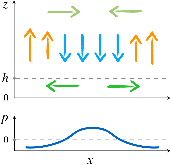Boundary Layer Height and Buoyancy Determine the Horizontal Scale of Convective Self-Aggregation
- Lawrence Berkeley National Lab. (LBNL), Berkeley, CA (United States); Univ. of California, Berkeley, CA (United States); Univ. of California, Davis, CA (United States)
Organized rainstorms and their associated overturning circulations can self-emerge over an ocean surface with uniform temperature in cloud-resolving simulations. This phenomenon is referred to as convective self-aggregation. Convective self-aggregation is argued to be an important building block for tropical weather systems and may help regulate tropical atmospheric humidity and thereby tropical climate stability. Here the author presents a boundary layer theory for the horizontal scale λ of 2D (x, z) convective self-aggregation by considering both the momentum and energy constraints for steady circulations. This theory suggests that λ scales with the product of the boundary layer height h and the square root of the amplitude of density variation between aggregated moist and dry regions in the boundary layer, and that this density variation mainly arises from the moisture variation due to the virtual effect of water vapor. Furthermore, this theory predicts the following: 1) the order of magnitude of λ is ~2000 km, 2) the aspect ratio of the boundary layer λ/h increases with surface warming, and 3) λ decreases when the virtual effect of water vapor is disabled. These predictions are confirmed using a sui te of cloud-resolving simulations spanning a wide range of climates.
- Research Organization:
- Lawrence Berkeley National Lab. (LBNL), Berkeley, CA (United States)
- Sponsoring Organization:
- USDOE Office of Science (SC); Univ. of California, Berkeley, CA (United States)
- Grant/Contract Number:
- AC02-05CH11231
- OSTI ID:
- 1433115
- Journal Information:
- Journal of the Atmospheric Sciences, Vol. 75, Issue 2; Related Information: © 2018 American Meteorological Society.; ISSN 0022-4928
- Publisher:
- American Meteorological SocietyCopyright Statement
- Country of Publication:
- United States
- Language:
- English
Similar Records
Boundary Layer Diabatic Processes, the Virtual Effect, and Convective Self‐Aggregation
Convective Heating Leads to Self‐Aggregation by Generating Available Potential Energy






